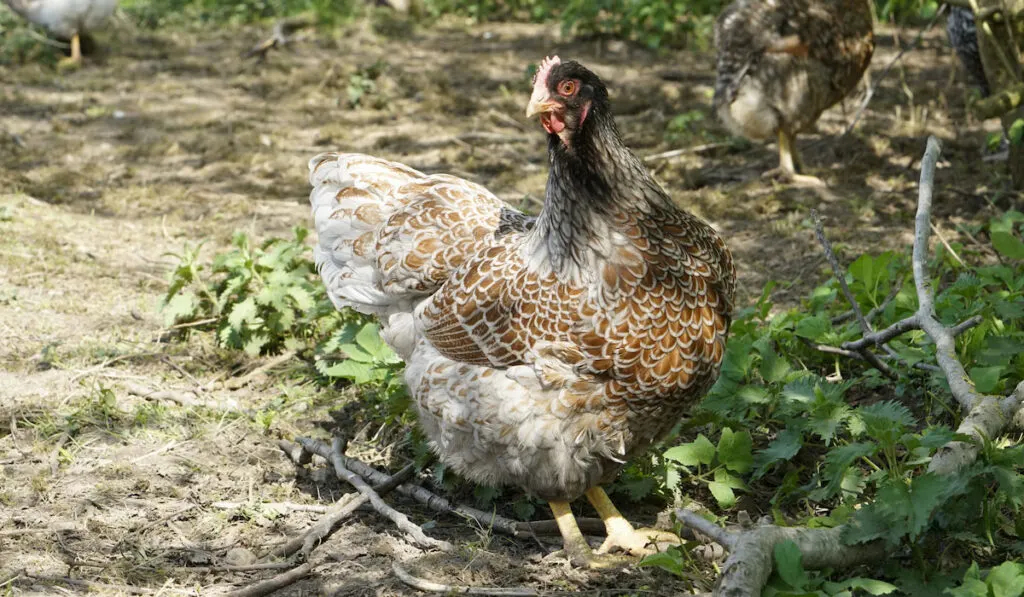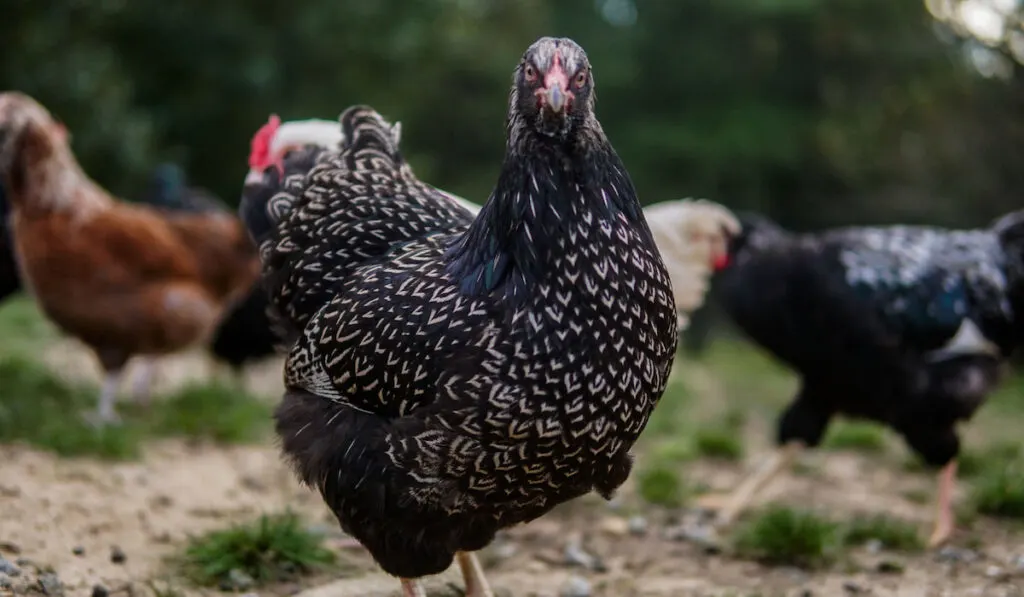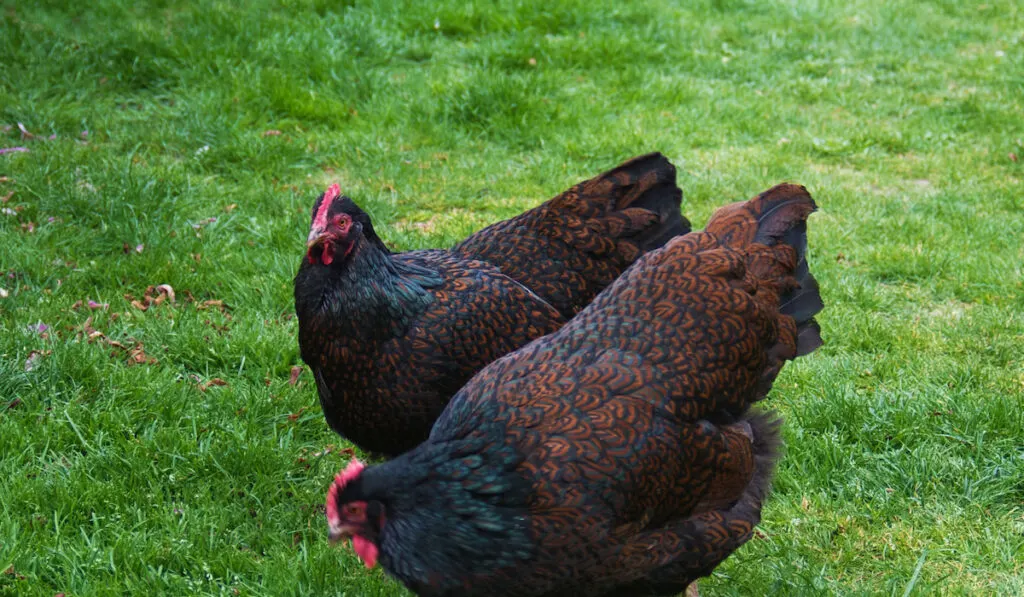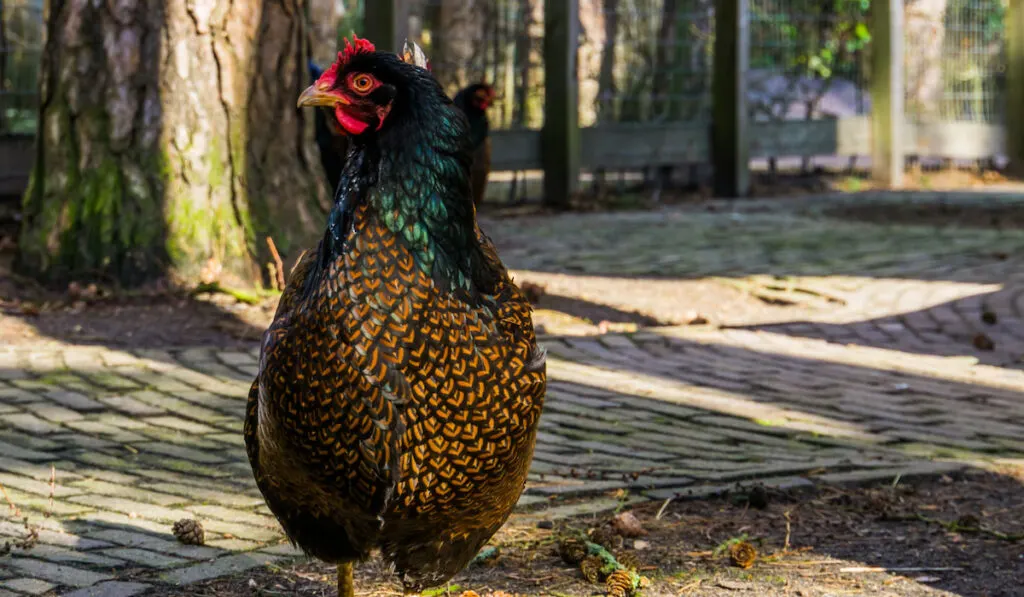Barnevelders or Barnies are beautiful chickens raised across the world for the colorful patterns of their feathers and their reputation as being a hardy breed.
These birds have sweet personalities and other fine attributes, so it is not surprising that they are becoming more and more popular.
If you’d love to raise chickens, it’s a great idea to start with Barnevelders because they are easy to raise. However, you should read this article first to know about Barnevelder chickens before you start raising them.

Table of Contents
History and Origin
Frankly speaking, Barnevelders are relatively new birds (when compared to others). They originated from Barneveld, which is east of Utrecht in the Netherlands.
They are from a place with a large agricultural college that specializes in poultry. Barneveld exports eggs to many places in Europe such as England.
England and other European regions started growing interest in brown eggs, so people made efforts to form the Barneveld Breeders Association.
This association helped to increase the production of Barnevelder chickens and in 1923, Barnevelder became a standardized breed.
In America, the beautiful breed became recognized by the American Poultry Association as a continental breed in 1991.
Characteristics
These low-maintenance birds have patterns that you can easily identify. Like most chickens, they cannot fly. However, they can make very high jumps. Let’s look at their qualities in detail.
Weight
These beautiful birds can reach considerable weight.
Most Barnevelder chicken hens weigh around 5 to 6 pounds (2.2 to 2.7 kg) or more. Roosters weigh 7 to 8 pounds (3 to 3.5 kg) or more.
The weight of your birds depends on what you feed them and how you care for them. The more nutritious foods they eat, the larger (heavier) they will become.
Color
The most noticeable feature of Barnevelder chickens is their color. Their black or brown feathers have double black lacings at the tips to make an arrowhead effect.
The feathers on the neck are black and have no patterns. Like many other chickens, the wattles, comb, and ear lobes are all shiny red. Their beaks are cream or light brown.
Note that most of these features are visible mostly or only in hens.
Eggs
These birds lay three to four eggs weekly. However, their production of eggs can stop when the temperature conditions are not so favorable, especially during frost.
Their eggs are dark brown. Occasionally, the eggs come with speckles.

Lifespan
Barnevelder chickens will live for seven or more years when the conditions are right for them.
So long as you do not stress them and as long as you give them quality food and clean water, they will stay healthy for a long time.
You should give them extra care when the atmosphere is hot because they become weak in such periods. Also, ensure that you use quality feed when feeding them
If you are raising chickens for agricultural purposes, you do not need to wait years or longer because these birds will reach maturity in less than six months.
However, if you are raising them as pets, you will surely be interested in the lifespan so that you can know for how long you are keeping the birds.
Sexing
Of course, it is very easy to differentiate roosters from hens. For this breed of chicken, sexing is very easy.
Aside from the physical differences such as longer wattles and feathers, roosters do not have brown-arrowed patterns on their feathers, especially the ones around their necks.
People have tried to give roosters the beautiful patterns that hens have but they have not been successful so far. Well, the roosters are equally beautiful and calm just like the hens.

Behavior and Temperament
Both male and female Barnevelder chickens are very calm. These birds have a docile temperament and make great pets. They are very chatty but are not so loud that your neighborhood will be subjected to noise.
Barnevelder chickens usually run away from people, but if you can train them well, they will run to you (and others that they know) and feel safe. You just need to be patient with them.
Note that the males can be territorial, especially when there are many males or when there are limited food, space, and mates.
Uses
From their history, it is clear that these birds were originally demanded in significant numbers because of the color of their eggs. However, their uses over the years have increased, so you now have so many reasons to raise them.

Egg Laying
The beautiful chickens produce three to four large eggs every week. This means that you can get an egg from a single hen every two to three days.
Awesome, right?
Many people continue to prefer brown eggs today, so the eggs of Barnevelder chickens are still in high demand.
Their eggs can be used for anything the average chicken egg can be used for, boiling, frying, baking, etc.
In the winter months or when the conditions are not so favorable, Barnevelder hens may stop laying eggs. It might be a great idea to leave the chickens to rest during that period.
However, you can help them to continue laying eggs by raising them at the ideal temperature.
All you need to do is control the temperature of their coop to fit in with the ideal egg-laying weather conditions.
Meat Production
Even though these chickens are popular egg layers, they also produce about 6 to 8 pounds of meat when they mature.
Barnevelder meat is not tough, it tends to stay tender when cooked.
Even though you are raising them for their eggs, you can still get meat from them when they are mature.
However, note that these birds were primarily raised to lay eggs. They may therefore not give you as much meat as other meat-producing birds because the content of their feed is different.
As Pets
Due to the very sweet personality of Barnevelder birds, you can train them as pets. It is very easy to tame them so that they can become fine pets.
You only need to start training them (when they are young) so that they can learn early.
Your kids will be very safe with the birds, so you do not need to entertain any fear that birds might cause any harm to them. Your kids can even play with the birds if they want.

Hatching and Raising
As soon as you have chicks, vaccinate them against diseases and viruses that infect birds in your area.
So long as your chickens are vaccinated, you will raise them easily because they are a hardy breed.
Incubating and Hatching
Barnevelder hens are not good brooders, so the percentage of eggs that hatch under the care of broody hens is quite low.
This means that if you want to incubate the eggs of your Barnevelder chickens, you should consider using other options.
Some other options to consider are:
- Use brooders: You can choose to add the eggs of your Barnevelders to the eggs of an experienced mother chicken in your farm or home. Just make sure that you add the eggs as early as you can.
- Use an incubator: Using an incubator is good and when done well, you will get many chicks. Remember to turn and candle the eggs regularly.
In 21 days, the eggs should hatch into chicks.
Housing
A standard coop size for Barnevelder chickens is 4 to 5 square feet per bird. The coop should be insulated against the freezing weather conditions of winter months, but it should also be well ventilated against hot summer months.
You can achieve this by having windows (protected with a mesh), mulch, a heat lamp, and other items in the coop.
It would also help to provide a roosting area either inside or very close to the coop so that your chickens can rest there whenever they want. As a general practice, remember to clean the coop regularly.
If you see some chickens refusing to go back to their coop at night, it could be because the coop is too full. Always check the number of your birds to see if they’re okay for the size of your coop.
If you are raising birds as pets, remember to provide a comfortable sleeping area for the birds so that they do not sleep on the bare floor. Also, allow them to go out sometimes.

Feeding
Like other chickens, the beautiful Barnevelder chickens love to free-range and are very good at it. You should not keep your birds locked in a coop, especially when you have an open space.
Asides from food from free-range, you should feed your birds with:
- Mash: Formulated feed is essential for chickens because it contains just the right proportion of nutrients for the birds. You need to use the right feed for the right bird according to the age of the bird.
- Bug treats: Every bird loves its bugs. If you have treats such as insect larvae, give them to your birds, they’ll appreciate it.
- Grains: Grains are essential sources of carbs and other nutrients for your chickens. Chickens can get a lot of carbs and proteins from different types of grains such as corn, wheat, oats, etc.
- Fruit treats: Birds love delicious fruits such as bananas, apples, watermelons, etc. Give fruits to your birds when the air is hot. Especially during hot summer months.
Make sure that your birds do not go hungry.

Winter Care
Barnevelder chickens do not need much winter care, as they are cold hardy. In fact, they prefer cold to hot seasons and can look weak when the atmosphere is hot.
However, you still need to care for your chickens when winter arrives. Here are some winter tips:
- Coop insulation: You should add an extra layer of hay or straw to the floor of your chicken coop so that the feet of your birds will not have contact with the cold floor. Also, install a heat lamp.
- Feeding: Make sure that your chickens do not run out of food because they need the energy to stay warm. Also, feed them with a grain-rich mix regularly.
- Water: While you have to give your chickens clean water, you should also make sure that the water is not freezing or cold. The water’s temperature should be within the range of room temperature.
- Keeping the chickens active: It would help to keep your chickens active by giving them treats, allowing them to go outside sometimes, and hanging a fruit or vegetable piñata so they can peck at it sometimes.
So long as you can stick to the tips and advice, your beautiful chickens will stay happy throughout the winter.
Final Thoughts
Barnevelder chickens are very beautiful, so you can keep them as pets even though they are awesome egg layers and meat producers. Remember to keep your chickens happy by always providing them with food and clean water.
